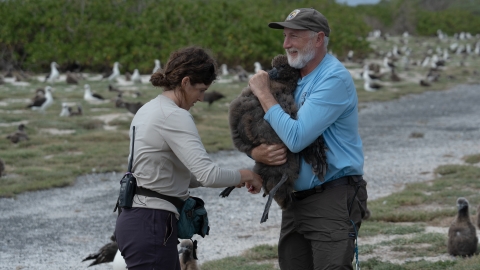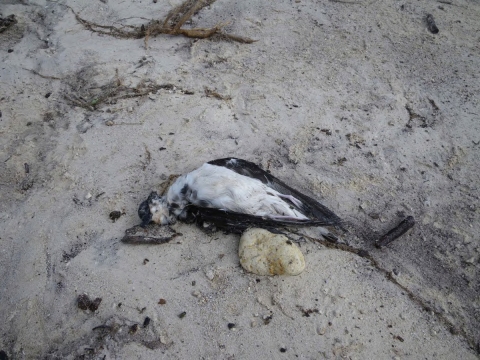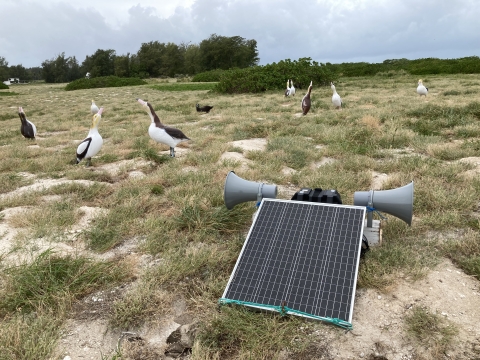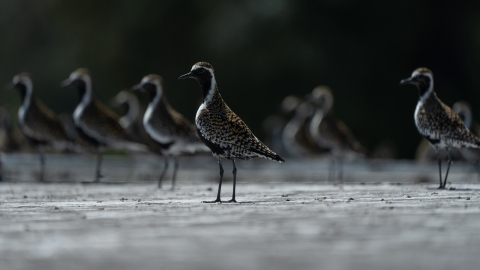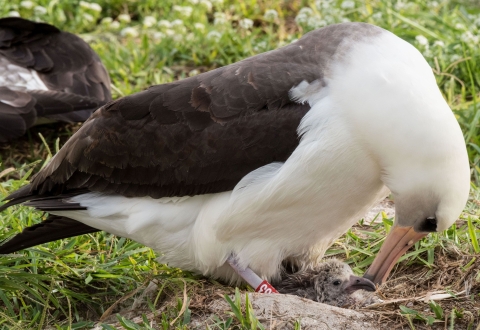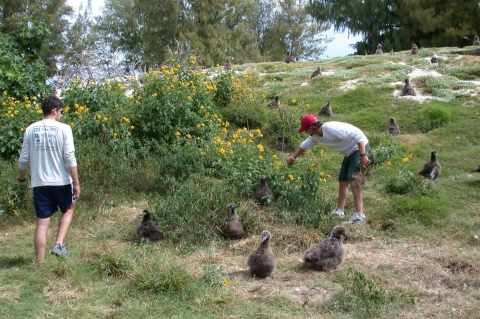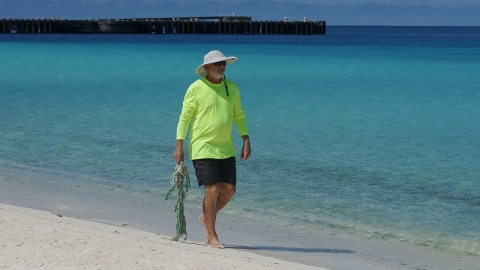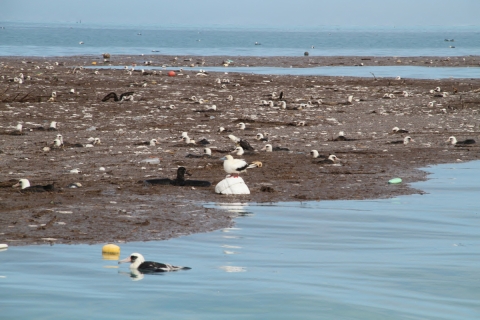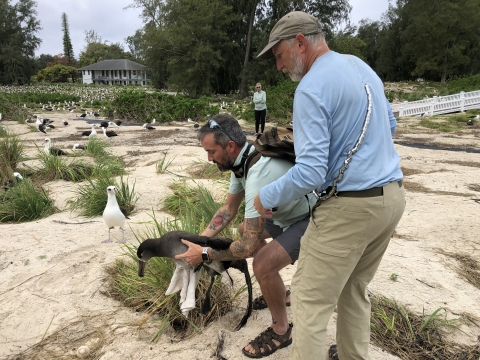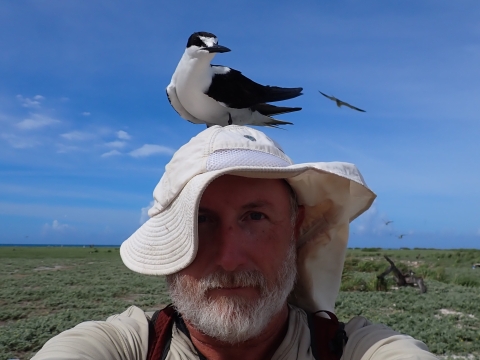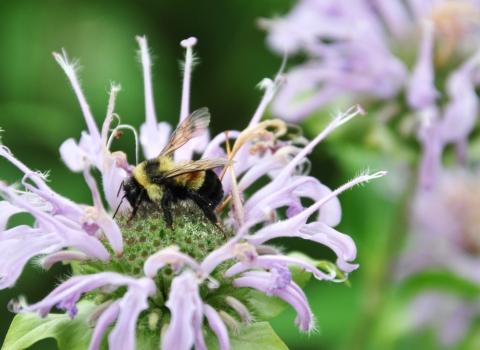Jon Plissner recounts his intimate connection with Kuaihelani (Midway Atoll) and its creatures, providing a deeper look into adapting to the spellbinding frequencies of the Midway Atoll National Wildlife Refuge and Battle of Midway National Memorial (Midway Atoll) realm, the challenges confronting Midway Atoll and its species, and some of Midway Atollʻs surprising and fascinating secrets.
Profile story: Jon Plissner
Since 1996—when full jurisdiction of Midway Atoll was granted to the U.S. Fish and Wildlife Service—less than 300 refuge personnel, volunteers, and contract support staff have had the privilege to call Midway Atoll their year-round home. As fascinating as Midway Atoll is with its gorgeous beaches, phenomenal wildlife, as well as mesmerizing landscapes and sunsets, for many it’s a short-term refuge assignment. The remoteness of Midway Atoll can have anyone immensely missing family, friends, and the comforts of home. Only a handful of staff ever contemplate living and working on Midway Atoll for five years or more. One of those select few is Jon Plissner, supervisory wildlife biologist, who in 2024 has surpassed seven years residing at Midway Atoll.
Love at First Flight
Needing a break after approximately 15 years of a fast-paced lifestyle in environmental consulting, Jon Plissner first landed on Midway Atoll in 2017 to serve as a 6-month volunteer from March through November. Immediately before Midway Atoll, most of Jon’s opportunities in environmental consulting had become just “pieces of a mosaic of seasonal projects” where he wasn’t getting to visit the places where the field work was conducted. Instead, he managed projects far from these places, unable to forge connections directly with the land and its inhabitants.
For Jon, Midway Atoll meant a chance to immerse himself full-time in a world of birds, which have been the passion of his career and life. But beyond the birds themselves, coming to Midway Atoll was his first opportunity to develop a deeper understanding of the birds’ habitats, while learning about managing habitat to benefit their populations.
“I knew about the albatross, but the sheer numbers and their coverage across the island can’t be captured in photos or descriptions. I felt and still feel equally astonished by the Bonin petrels that fill the skies in the evening and cover the ground throughout the night for most of the year.”
Midway Atoll is most notably and widely recognized as a refuge for seabirds. The vast majority of arthropods, reptiles, and plants, and one of the two wild mammals that inhabit the land at Midway Atoll are non-natives, being introduced by humans and possessing much larger populations elsewhere. However, most birds and all seabirds, inhabited Midway Atoll long before any humans stepped foot on the atoll. And today Midway Atoll is home to the world’s largest breeding populations of at least three species of seabirds (Laysan albatross, Black-footed albatross and Bonin petrels) and the Laysan duck, the second most-endangered duck in the planet.
By November 2017, Jon quickly realized that 6-months only whetted his appetite to see the entire annual cycle of life at Midway Atoll. Eager to continue working at Midway Atoll, Jon got hired by Island Conservation (IC) to collect baseline data for a project to benefit seabirds by eradicating non-native house mice - something he ended up doing for three years at Midway Atoll given the several postponements of this seabird protection project. To this day, that job has been Jon’s favorite all-time experience at Midway Atoll. As his contract with IC was expiring, an opportunity to apply for a term biologist position with USFWS at Midway Atoll came up, and in October 2020, Jon became a USFWS employee. Subsequently, Jon became the supervisory biologist – a position he has now held since 2022.
This is how Jon describes what Midway Atoll means to him—what he loves about Midway Atoll and some of the natural wonders that have captivated him at Midway Atoll:
“For me, Midway Atoll is a place to connect with and focus on a particular ecosystem, through all of its seasons and across multiple years of constant change.
Being surrounded by birds is what I treasure most about Midway Atoll, but its remoteness is also something I greatly treasure at this point in my life. Honestly, Midway Atoll has been a refuge for me too. It’s been increasingly difficult to listen to the news of the world and feel positive about the current and future state of humanity. Not only is it easier here to detach from the troubles of the rest of the country and world, but it is also a place where I can concentrate on and see positive impacts of my decisions and actions on my immediate environment.
For years, Iʻve been most fascinated by the sightings of banded albatross because I am constantly learning from their individual stories. Wisdom’s tale is the most famous Midway Atoll wildlife story, of course, but I love finding a bird in an unexpected location, and especially seeing those with color bands that instantly let me know that they were originally banded far from Midway Atoll. I then enjoy finding out their origins, sometimes from banding records that I have available right here, but occasionally by reaching out to the United States Geological Survey Bird Banding Lab for help or, and on rare occasions, reaching out to colleagues in Mexico or Japan to help in identifying birds banded on their respective islands. I’m also captured by the lives of local birds and getting to know individuals, and where to expect to see them nesting year after year, or learning where a bird that was banded here as a chick ends up settling down to begin raising its young.”
For broader perspectives on what life is like at Midway Atoll, let me pause on Jon and share some thoughts from my personal experiences at Midway Atoll and interactions with some other people who at some point in their lives, lived there for a year or more. To no surprise, what many of them missed (or still miss) the most while living at Midway Atoll include: family, friends, pets, mountains, rivers, snow, cold weather, food diversity, city lifestyle and venues, road trips, gardening, hiking, among an endless list of everything else that can’t happen at Midway Atoll. I feel that to surrender just the first three items on that list, one must be absolutely captivated, and in a certain way (or many ways) - transformed - by Midway Atoll. Just being fascinated with Midway Atoll doesn’t seem to cut it. I feel that in order for folks at Midway Atoll to live for years without family and a limited number of close friends, they must possess a tremendous amount of self-love and security in self, a free spirit, and a deep atonement with their inner wisdom. What I learned from Jon on this topic, is that from his life in the continental United States what he misses the most includes fresh fruit, his own vegetable and flower garden, his Breeding Bird Survey routes, good beer, spending time with his closest friends, Mexican cuisine, snow and cold weather, crab, and halibut.
Isolation in the realm of Pō
Kuaihelani lies within the sacred area of Papahānaumokuākea Marine National Monument that is contained in the realm of Pō, which according to Native Hawaiian oral traditions, is an entirely divine source of creation, a primordial realm of darkness from which all life emerged and evolved from, and where ancestral spirits returned to after death and were deified into gods. Pō is the realm of the deceased, ancestors, spirit, mystery, the unknown, and the not yet born. For many people, there may be difficulty connecting to this realm, while for others it is a place of resonance, nothing short of illuminating. It is not easy to surrender to everything that Midway Atoll is, because it requires surrendering aspects about one’s identity that are of no use when at Midway Atoll. I asked Jon what he’s learned about himself that he attributes to Midway Atoll and if he’s experienced any epiphanies at Midway Atoll.
“The most important epiphany for me personally has been that I feel content being at Midway Atoll and with my life in general. And that I am much more at ease being content than actually being happy, which to me is a more fleeting emotion and has tended to be accompanied by emotional swings in the other direction as well. Midway Atoll has grounded me in a very positive sense, I believe. I’ve learned from the community here to avoid and generally lose interest in human drama. I’ve seen the toll it has taken at times on how well this small community now interacts and functions.
Wildlife drama is much more interesting to me. I’ve learned to appreciate making short-term connections with people who are only here for a few days or weeks, but who I am unlikely to ever see again. I’ve also learned that no one should ever consider themselves irreplaceable. I have had the privilege to work with a number of remarkably talented young biologists here. Midway Atoll’s biological programs succeed only because of the efforts of these dedicated junior staff and volunteers, and I lament the struggles that most have to find permanent or at least longer-term jobs in the areas of expertise that they develop and love. There is certainly value in continuity and consistency and experience with any project or program, but there comes a time when it is best to hand over the reins to someone with fresh energy and new perspectives and to provide them with (and hope they learn from) what has been done in the past. I’ve learned to accept that they will likely move in new directions as well.”
Jon’s recollections are compelling and insightful. Some come across as challenging biases of what one may expect to hear from a biologist in the field. Though Jon demonstrates deep acknowledgement of the cultural heritage while holding reverence for Midway Atoll as a special place.
Jon shared some perspectives on how he has adapted to living, constantly surrounded by millions of seabirds:
“Humans are amazingly adaptive, sometimes to a fault, and we can habituate to such a wide range of environments. As a graduate student, I lived for a while in a house adjacent to a busy railroad, but soon didn’t even notice the loud sounds of the trains passing by. Initially, the sights and sounds of Midway Atoll are overwhelming. Traversing a field of petrel burrows is daunting. And sleeping can be challenging through the cacophony of courting albatross and petrels that also have a habit of pecking incessantly at windows and glass doors. But soon it all becomes background noise and images, and even walking through the petrel colony becomes routine and somewhat achievable without crushing through a burrow.
One of the biggest adjustment challenges is to accept the spectacle of both life and death encountered throughout most of the year. There is a tendency for most visitors and other new arrivals to feel a need to “do something” about every sick or injured bird they encounter. For me, it’s been an adjustment to accept death as just a part of the natural process here. I remain cognizant of how much I have habituated to the Midway Atoll environment and make the effort every so often to just look around and appreciate how rare and magnificent this experience is.”
Yet, Jon considers Midway Atoll to be “nicely semi-isolated”. Over the years, Jon has enjoyed the limitations of connecting with the outside world more than he’s ever been frustrated by it. Recently Midway Atoll adopted Starlink, a satellite-based service providing highspeed internet and Jon shares the effect that had on people at Midway Atoll.
“I have deeply mixed feelings about the arrival of Starlink here. I have already seen it change the way that people spend their free time here, spending more time online and less time exploring the outdoor environment or even socializing within the community. It is changing the Midway Atoll experience. I’ve developed more fondness for having time to myself. Again, it may be mostly just habituation to life here, but I’ve found that I now need some time to myself each week, whether I’m here or spending time off-island. I still enjoy being social, but in much more limited doses.”
Immersed with the Midway Atoll Wildlife
When asked, what the most exciting part of his job is? It was not surprising that for Jon nothing tops banding a short-tailed albatross (STAL) or just being up close to an incubating adult albatross. Jon’s fascination with short-tailed albatross stems from a combination of them being so much larger than the other albatrosses at Midway Atoll, and them being so rare as a species that it was thought to be extinct a century ago.
Jon feels honored to be witnessing STAL nesting at Midway Atoll once again, especially with young birds returning that could potentially lead to the development of a breeding population. Kure had a young bird from the Torishima population that stopped there for the first time in late 2023. This happens to be great news in confirming that there are birds from elsewhere exploring the area. Jon explained that translocating birds from Japan is politically and culturally challenging, and successfully translocating albatross is a lot more challenging and labor intensive than translocating other species like Laysan ducks or finches.
“We should probably intensify our efforts to attract more birds here before we press harder for translocation. We currently have decoys up and a sound system running with vocalizations of courting short-tailed albatrosses at a site with higher elevation and further from the runway than where the birds currently nest, but we haven’t had any evidence of birds visiting the site. The question of whether Midway Atoll will persist as a site that can sustain nesting habitat for seabirds has to be a consideration for deciding if we should encourage and invest in development of a sustainable population of STAL here.”
A fascinating STAL discovery that Jon was a part of involved, seeing a short-tailed albatross that hatched at Midway Atoll, then returned and spent considerable time near its parents’ nest after just 2-3 years at sea. For Jon it was especially thrilling to see the return of the chick from the first documented nest on Sand Island, because Jon was the last person who happened to see it in May 2019, before it fledged nearly a month earlier than any of the chicks that fledged from Eastern Island between 2011 and 2014. Jon feared that just his presence during that moment had somehow caused the fledgling to leave prematurely, so he was relieved to have the pair’s subsequent chicks also leave around the same period in May. Though it wasn’t until Jon witnessed the 2019 chick’s return to Midway Atoll in 2021 that its survival was ultimately confirmed.
Where capturing every detail becomes his daily mantra
To many who live and have lived in Midway Atoll, life can feel highly monotonous. A feeling exacerbated when limited to co-existing with large bird colonies on less than 1400 acres of atoll. This is another reason why for most people who work at Midway Atoll year-round tend to experience a short-term assignment. However, some folks, like Jon, are so immersed in this wild realm that they capture every detail including new discoveries.
Some of Jon’s favorite discoveries and curiosities on Midway Atoll include:
- Finding albatross that were banded somewhere other than Midway Atoll, including birds from Japan and Guadalupe Island (Mexico), as well as from other Hawaiian Islands. It’s been especially interesting to see how many black-footed albatross that were banded as chicks on Kure have come to Midway Atoll to nest.
- Finding vagrant birds such as northern lapwing, little ringed plover, far eastern curlew, and Baikal teal that have rarely if ever been seen before in the Hawaiian Islands.
- Discovering the world of nudibranchs while snorkeling.
- Watching a 12-ft tiger shark suddenly accelerate toward and narrowly miss catching an adult albatross that took off from the water just as the shark surfaced, jaws agape, to grab it.
- Watching tropicbirds, both red-tailed and white-tailed, perform their courtship flights in the middle of the day.
- Wondering why Bonin petrels fill the evening skies of Midway Atoll for 4-5 months before they lay their eggs, which part of that is still a mystery.
- Learning that hybrid albatross are fertile and can occasionally find mates and produce young.
- Finding out the reason why kolea (Pacific golden plover) occasionally stand in formation (see image below) on the tarmac in front of the Naval Air Facility hangar is due to pockets of water collected at tie-down anchors on the airplane parking ramp, where one bird would stand at each tie-down in equidistant formation
Wisdom in Midway Atoll
Jon has gotten to work closely around Wisdom, the oldest known wild bird in the planet. Wisdom, is a mōlī (Laysan albatross) and the world’s oldest known, banded wild bird. Wisdom is at least 73 years old. Although Jon has always been more interested in bird populations than individual birds, he also recognizes the conservation value of publicly focusing on individual birds. Jon explained that after E.O. Wilson brought the concept and value of “biodiversity” into the public consciousness as a primary argument for supporting conservation initiatives in the late 1980’s, Jon felt that it failed to motivate non-scientists to prioritize the conservation movement. Shortly afterward, a red-tailed hawk in New York City was given the name Pale Male and his life story was followed by millions of people. Jon realized that we are a culture absorbed by celebrity and that people become more invested and more easily connect with individuals that are given names than the importance associated with of large numbers or populations of a specific species.
“Wisdom is a classic example. It’s really amazing to encounter the world’s oldest known wild bird and see her add to the record year after year, but it fascinates because of its apparent uniqueness and not for any scientific or conservation or management implications. It’s interesting that the next oldest bird here that we know about is currently just 45+ years old. Almost thirty years apart in age is a big gap, especially with the tremendous number of albatross that were banded here in the 1960s. What Wisdom represents to me is really two-fold. First, because of the attention she draws, she demonstrates the value of banding birds. It is only because of the banding program that has taken place here since 1936 that we have been able to recognize Wisdom’s accomplishment. Second, Wisdom represents a connection between me and Chandler [Chan] Robbins (FWS ornithologist who first tagged Wisdom in 1956), the lead author on my first field guide that I began studying and annotating prodigiously when I was 7 years old and completely wore out from use in 4-5 years. As a young and enthusiastic birder, I met the man once during an event of a local birding club in northern Virginia. Until coming to Midway Atoll, I also participated in each of 20 years in the Breeding Bird Survey program that Chan developed in the 1960’s. Now, this one magnificent individual bird continues to remind me of his influence on my career and life.”
Restoring Midway Atoll’s Land Habitat
One of the top conservation success stories on Midway Atoll is the progress made so far eradicating Verbesina from the atoll. This has led to improving nesting habitat for seabirds and facilitating re-establishment of native habitat. Jon feels this decades-long feat has not gotten the attention that it deserves. The two contrast photos below (before and after Verbesina control) reveal the magnitude of what it took to achieve this milestone.
Several characteristics of this invasive plant make it very difficult to control, let alone eradicate; making the success of the eradication project all the more remarkable. Just three to four years ago, Jon and other staff felt skeptical that they could completely remove it, but the results of the efforts since that time now have Jon convinced that the complete eradication can be accomplished for Eastern Island in the next three to five years and in just a few more years for Sand Island with the current level of effort tapering off during that time period. Jon’s colleague from New Zealand who has worked extensively on weed control and eradication efforts on islands, indicated that complete eradication of an invasive species invasive species
An invasive species is any plant or animal that has spread or been introduced into a new area where they are, or could, cause harm to the environment, economy, or human, animal, or plant health. Their unwelcome presence can destroy ecosystems and cost millions of dollars.
Learn more about invasive species like Verbesina should be expected to take ~30 years of intensive effort. Thanks to ongoing devoted efforts, the Service could be at a point in less than half that time when continued progress toward eradication only requires focused efforts on a small portion of the atoll and periodic monitoring elsewhere.
“We’re not there yet, but even after the amount of the island covered by Verbesina was reduced by more than 99% between 2011 and 2017, we’ve documented a further reduction of plants by more than 95% from 2018 to 2023. I’m proud to have been a part of this project but also fearful that it could still very easily fail entirely, if adequate effort to continue toward eradication is suspended. It is very difficult to continue to generate support for any long-term project, but especially for those with apparent success before the ultimate goal is actually achieved.”
Some non-native plants, however, actually serve Midway Atoll more than they harm. When Jon first arrived at Midway Atoll, he thought that he would be helping to restore native habitat across the atoll; but he has come to realize that native vegetation doesn’t necessarily always constitute better habitat for native wildlife than do invasive plants. Habitat restoration efforts require consideration and monitoring of how communities respond to restoration. Jon has always been a proponent of adaptive management and adjusting strategies while learning from each action taken. Jon believes that several of the native species that are now so abundant at Midway Atoll likely were less common before people planted ironwood trees and brought non-native grasses such as Bermuda grass that became established on the dunes of Sand Island.
Now that Midway Atoll is home to the largest breeding populations of several bird species, restoring native habitat won’t necessarily be the optimal approach for maintaining those and other imperiled populations and optimally there needs to be a balance of native and non-native habitat that best supports the diversity of native bird species. That being said, there are other aspects of habitat restoration that Jon is excited to be developing through a Habitat Management Plan for the Refuge. Other than what was included in the Papahānaumokuākea Marine National Monument Management Plan in 2008, the Service hasn’t developed a document identifying long-term goals for habitat management at Midway Atoll. Now that the staff are able to step away from planning and implementing the seabird protection project , Jon can spend time thinking more broadly about directions he’d like to see the biology program headed.
“We have some critical challenges facing us in relation to climate change climate change
Climate change includes both global warming driven by human-induced emissions of greenhouse gases and the resulting large-scale shifts in weather patterns. Though there have been previous periods of climatic change, since the mid-20th century humans have had an unprecedented impact on Earth's climate system and caused change on a global scale.
Learn more about climate change , including the question of whether or not the islands of Midway Atoll will even exist in another century. But more immediately, there are concerns about survival and reproduction of albatross and other seabirds in light of increasing temperatures and possibly availability of food resources at sea, and we are looking at ways that we can modify habitat here to at least mitigate some of the negative effects. I am looking forward to expanding our monitoring of other seabird species here, especially those such as masked and brown boobies, Tristram’s storm-petrels, Bonin petrels, and possibly Bulwer’s petrels as their populations continue to recover following eradication of rats in the mid 1990’s.”
The one ongoing habitat research project that excites Jon the most is a study in progress that will help determine which Midway Atoll habitat provides for the greatest nest success for the Laysan albatross and black-footed albatross. This study will help determine the effects of habitat restoration on both species of albatross by following nests in different habitats this year, with a total of four years of data to be analyzed in a few more months. The results will greatly help steer future habitat management objectives.
The Future Picture Dilemma
Currently, Jon foresees Midway Atoll becoming much smaller in the near future due to sea level rise. unless funding can be obtained to repair the seawall that is quickly deteriorating, which is an immediate threat to the integrity of Sand Island. Without the seawall, bringing in vessels to resupply the island would not be possible
“We have had storm events the past few winters that have resulted in overwash of the seawall and flooding of several areas with high densities of albatross nests. Even less severe rain events can wipe out hundreds or thousands of nests with eggs or young albatross and flood petrel burrows. I have to admit, though, that I hope each year for early storms that do their damage while birds are still on eggs rather than watch chicks drown.”
Jon explains that Midway Atoll’s wildlife populations are still recovering from catastrophic losses over the past century and a half. They now represent the largest and arguably most important populations of their species. Other seabird species such as Tristram’s storm-petrels, Bulwer’s petrels, and the three booby species are still slowly increasing after habitat losses and predation by rats through most of the 20th century. As other islands in the Northwestern Hawaiian Islands chain lose areas from climate change impacts, Midway Atoll’s beaches may become more important breeding grounds for green turtles and Hawaiian monk seals. Protecting these species and perhaps providing a refugia for others that are endangered elsewhere to survive should be the most important mission at Midway Atoll. While recognizing the historical and cultural significance of the atoll, Jon’s ideal scenario would be to have Midway Atoll become home to a research institute along the line of the Smithsonian Tropical Research Institute in Panama and a center for study of climate change impacts in the Pacific.
The Future’s Bright Side
Jon has always felt excited to further Midway Atoll’s role as a refugia for endangered plant and bird species. Now that there are mature plants producing seeds, the refuge staff have been propagating hundreds of loulu (Pritchardia remota), the endangered Nihoa fan-palm, and hope to see them get established across the atoll. Jon would like to work with colleagues from the Ecological Services division to identify additional native Hawaiian plants that might benefit from having a supplemental population established at Midway Atoll.
As the short-tailed albatross pair continues nearly every year to successfully raise chicks and have some return to Midway Atoll after only a few years at sea, Jon is hopeful that others will be attracted to Midway Atoll as well, and that there will be more pairs nesting in a few years.
Jon is also enjoying the discussions about the possibility of translocating Laysan finches from Pearl and Hermes to Eastern Island to enhance recovery efforts for that species.
Like everyone at Midway Atoll and beyond, Jon is pained that the Service didn’t succeed in removing mice from Sand Island last year, and that it may be years before the next attempt. Jon sees hope that with the advent of new methodologies and with lessons learned from 2023, we will be able to remove the last remaining introduced rodent population in the Northwestern Hawaiian Islands. Lastly, Jon aspires that successful and safe methods for eradicating mosquitoes will soon be developed and implemented not only to save Hawaii’s native forest birds but also to prevent threats of avian pox and malaria for Midway Atoll’s current bird populations and for species such as Laysan finches that might be translocated there in the future.
To this day, Jon’s all-time favorite experience at Midway Atoll occurred before he began working for the Fish and Wildlife Service when he conducted studies for Island Conservation as a contracted biologist collecting baseline data on abundance of plants, arthropods, and birds over a 3-year period before the anticipated Seabird Protection Project focused on house mouse eradication. He loved being involved with a study that was specifically designed to quantifiably measure effects of a management action and also inform future projects elsewhere.
“I’ve always been impressed by the work of Island Conservation and am proud to have worked with such an amazing organization and group of people. I enjoyed the wide scope of the project and think I was able to learn a great deal about a wide variety of plants and animals at Midway Atoll, even though we are unable to achieve the initial goals we had set because we failed to remove mice from the atoll.”
Jon also experiences much joy outside his shift hours. It is clear that he prefers outdoor pastimes (bird-watching, looking for banded albatross, snorkeling), but he has much fun indoors too playing pickleball and hanging out in the evening with other members of the Midway Atoll community, consisting primarily of Thai contractors. Since Midway Atoll is an insular area of the U.S. and an unincorporated territory, the contracted manager of the atoll’s facilities, Chugach Solutions Enterprise, LLC, an Alaska Native Regional Corporation., hires about 40 Thai workers that maintain the Midway Atoll facilities.
“I also spend a lot of my free time indoors managing Excel datasets, especially albatross data from ~27 years of observations on thousands of banded birds. A lot of the data failed to get adequately checked for errors, resulting in years of delays for it to be analyzed. I enjoy “data sleuthing,” finding errors and the looking through old records to determine how many errors can be corrected. I also love to dig through the data to answer questions that others ask or that I think about and realize that the answers lie hidden in the data that were collected to answer other questions.”
Jon takes a break from Midway Atoll just once or twice a year, usually for 4 weeks at a time.
“I’m always a bit surprised that I don’t have more of a culture shock when I step back into normal society. I always expect that I will be flustered by driving a car or food prices or street crowds or the glut of information flow; but it’s never been a problem. I do find that I am always eager to return to Midway Atoll by the end of any break, which I rarely felt about vacations while I lived on the mainland.”
Jon’s connection with Midway Atoll continues to evolve, as Midway Atoll provides him with a deeper sense of who he is and what he is yet to pursue, remaining enthralled with every breath he takes in the realm of Po.




